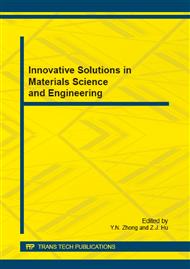[1]
D. Aramazotti, Plastics Products Design Handbook, ed. E. Miller, M. Dekker, New York, (1983).
Google Scholar
[2]
J. Frenkel, Viscous flow of crystalline bodies under action of surface tension. J. Phys. (USSR) 9 (1945) 385.
Google Scholar
[3]
Thümmler F., Thomma W., The sintering process, Metall. Reviews, (1967) 12, 69.
Google Scholar
[4]
Dedrick J.H., Gerds A., A study of the mechanisms of sintering of metallic particles, J. App. Phys., 20 (11), (1949)1042-1044.
DOI: 10.1063/1.1698271
Google Scholar
[5]
Coble R.L., Sintering crystalline solids. I. Intermediate and final state diffusion models, J. App. Phys., 32 (5), (1961) 787-792.
DOI: 10.1063/1.1736107
Google Scholar
[6]
Dong Wook Chae, Min Hyung Kim and Byoung Chul Kim, Temperature dependence of the rheological properties of poly(vinylidene fluoride)/ dimethyl acetamide solutions and their electrospinning, Korea-Australia Rheology Journal Vol. 22, No. 3, (2010).
Google Scholar
[7]
Eshelby, J. D., Discussion, " in A. J. Shuler, "Seminar on the Kinetics of Sintering, Metals Trans., 185, (1949) 806.
Google Scholar
[8]
Pokluda ,O., C.T. Bellehumeur and J. Vlachopoulos A modification of Frenkel's model for sintering. AIChE J., 43, (1997) 3253-3256.
DOI: 10.1002/aic.690431213
Google Scholar
[9]
Hopper, R. W., Plane Stokes Flow Driven by Capillarity on a Free Surface, J . Fluid Mech., 213, (1990) 349.
DOI: 10.1017/s002211209000235x
Google Scholar
[10]
Kuiken, H. Viscous sintering: the surface-tension-driven flow of a liquid form under the influence of curvature gradients at its surface. Journal of Fluid Mechanics, 214, (1990), 503-515.
DOI: 10.1017/s0022112090000234
Google Scholar
[11]
Van de Vorst, G. A. L., Modelling and Numerical Simulation of Viscous Sintering, PhD thesis, Eindhoven Univ. of Technology, The Netherlands , (1994).
Google Scholar
[12]
Rosenzweig, N., and M. Narkis, Sintering Rheology of Amorphous Polymers, Poly. Eng. Sci., 21, (1981) 1167.
DOI: 10.1002/pen.760211709
Google Scholar
[13]
Kuczynski, G. C., Study of the Sintering of Glass,J. Phys., 20, (1949), 1160.
Google Scholar
[14]
Hornsby, P. R., and A. S. Maxwell, Mechanism of Sintering between Polypropylene Beads, J. Mater. Sci., 27, (1992) 2525.
DOI: 10.1007/bf01105065
Google Scholar
[15]
Bellehumeur, C. T., M. K. Bisaria, and J. Vlachopoulos, An Experimental Study and Model Assessment of Polymer Sintering, Po&. Eng. Sci., 36, (1996) 2198.
DOI: 10.1002/pen.10617
Google Scholar
[16]
Lontz J.F., Sintering of polymer material, in Fundamental Phenomena in the Material Sciences, Vol. 1, Bonis and Hausner ed., Plenum Press, New-York, (1964).
Google Scholar
[17]
Mazur, S., and D. J. Plazck, Viscoelastic Effects in the Coalescence of Polymer Particles, Prog. Org. Coar., 24, (1994) 225.
Google Scholar
[18]
Du WeiWei, Un model Numérique et expérimental dans le cas de rotomoulage, Edition Universitaire Européenne, Germany, (2013).
Google Scholar


